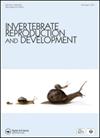Production of juveniles of the freshwater, egg-laying lymnaeid snail Radix plicatula as prey for the juveniles of Whitman leech (Whitmania pigra)
IF 0.8
4区 生物学
Q4 REPRODUCTIVE BIOLOGY
引用次数: 0
Abstract
ABSTRACT The leech Whitmania pigra is well known in traditional Chinese medicine for promoting human blood circulation and alleviating blood stasis. To evaluate its suitability as bait for this neonate leech, we investigate the reproductive efficiency of the snail Radix plicatula under laboratory conditions. Furthermore, the effects of the size of R. plicatula on the growth of newborn W. pigra were evaluated. Wild snails laid eggs in mid-March with body weight >0.223 g and peaked at the beginning of April to early May. The accumulated number of eggs was 1489.70 ± 895.98 and 2145.67 ± 694.47 separately for individual and paired snails (P = 0.083). The time elapsed up to the hatching of the first egg in the four collected egg masses ranged from 12 to 18 days, and the hatching percentage ranged from 97-% to 100-% . The predation rate of the newborn W. pigra was significantly higher when feeding on small snails than on medium and large snails (P < 0.01). Furthermore, increased snail size resulted in decreased leech growth and survival rates. The investigations demonstrated that the snail R. plicatula could serve as a suitable living bait in the rearing of W. pigra to help alleviate the scarcity of leech on the market.淡水产卵的纹螺(Radix plicatula)作为怀特曼水蛭(Whitmania pigra)幼体的猎物
水蛭在中医中具有活血化瘀的功效。为了评价其作为这种新生水蛭诱饵的适宜性,我们在实验室条件下研究了褶皱蜗牛的繁殖效率。此外,还评估了褶皱R.plicatula的大小对新生小猪生长的影响。野生蜗牛在三月中旬产卵,体重>0.223 g,4月初至5月初达到高峰,累计产卵1489.70枚 ± 895.98和2145.67 ± 个体和配对蜗牛分别为694.47(P = 0.083)。在收集的四个卵块中,直到第一个蛋孵化所经过的时间在12到18之间 天,孵化率在97%到100%之间 . 以小蜗牛为食的仔猪捕食率明显高于中、大蜗牛(P < 0.01)。此外,蜗牛大小的增加导致水蛭生长和存活率的降低。研究表明,褶皱蜗牛可以作为一种合适的生活诱饵来饲养猪水蛭,以帮助缓解市场上水蛭的稀缺性。
本文章由计算机程序翻译,如有差异,请以英文原文为准。
求助全文
约1分钟内获得全文
求助全文
来源期刊
CiteScore
1.90
自引率
0.00%
发文量
21
审稿时长
>12 weeks
期刊介绍:
Invertebrate Reproduction & Development ( IRD) presents original research on the reproductive and developmental biology of the Invertebrata, both embryonic and postembryonic. IRD welcomes papers reporting significant results obtained using new techniques. Encouraged topic areas include: aquaculture, physiology, biochemistry, functional morphology, phylogeny, behavioural and regulatory mechanisms, including genetic, endocrine and molecular studies. Papers containing qualitative descriptions of reproductive cycles and gametogenesis will not be considered. IRD is published in association with the International Society of Invertebrate Reproduction and Development.

 求助内容:
求助内容: 应助结果提醒方式:
应助结果提醒方式:


